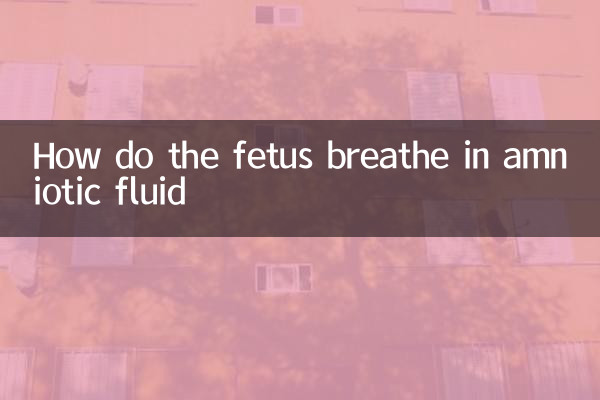Title: How do the fetus breathe in amniotic fluid
introduction
The fetus' respiratory mechanism is completely different from that of a baby after birth, which is a curious biological phenomenon. Many prospective parents will ask: How does the fetus breathe in amniotic fluid? This article will answer this question in detail and combine the popular topics and hot content in the past 10 days to provide you with scientific and easy-to-understand explanations.

1. The scientific principles of fetal breathing
The fetus does not breathe through the lungs in the mother's body, but relies on the placenta and umbilical cord to obtain oxygen and discharge carbon dioxide. Here are the key steps for fetal “breathing”:
| process | illustrate |
|---|---|
| Oxygen exchange | Oxygen in the maternal blood is transmitted to the fetus through the placenta and umbilical cord. |
| Carbon dioxide emission | The fetus' metabolic waste returns to the mother through the umbilical cord and placenta and is excreted from the mother. |
| The role of amniotic fluid | Amniotic fluid provides protection for the fetus and helps lung development, but is not a respiratory mediator. |
2. Exercises of fetal breathing exercises
Although the fetus does not need to breathe through the lungs, in the middle and late stages of pregnancy, the fetus begins to practice breathing exercises. The following are the relevant data:
| time | Respiratory movement frequency | significance |
|---|---|---|
| 16 weeks of pregnancy | Occasionally appear | Lung muscles begin to develop |
| 24 weeks of pregnancy | 30-40 times per minute | Prepare for post-birth breathing |
| Late pregnancy | Increased regularity | Promote alveolar maturation |
3. Related topics in the past 10 days
Recently, topics about fetal health and development have sparked widespread discussion on social media. The following are the hot topics in the past 10 days:
| Hot Topics | Discussion focus |
|---|---|
| The scientific nature of "Prenatus Music" | Can music really promote fetal brain development? |
| "Pregnancy Nutrition and Fetal Respiration" | How does maternal diet affect fetal lung development? |
| "Respiratory support technology for premature infants" | How can new technologies help premature babies transition to self-breathing? |
4. Answers to common misunderstandings
There are some common misunderstandings about fetal breathing, and the following is a scientific explanation:
Misunderstanding 1: The fetus will choke on amniotic fluid.
In fact, the fetus' respiratory tract is filled with amniotic fluid, but this is normal. Amniotic fluid is crucial for lung development and does not cause suffocation.
Misconception 2: Maternal hypoxia can lead to fetal asphyxia.
The placenta has strong compensatory capacity and can prioritize the supply of fetal oxygen. Only in extreme cases will the mother's hypoxia affect the fetus.
Misconception 3: The fetus will breathe immediately when it is born.
It takes several minutes to several hours for a newborn to adapt to self-breathing, which is a normal process.
5. Summary
The fetus' breathing mechanism is the embodiment of the miracle of life. Through the exchange of oxygen between the placenta and the umbilical cord, the fetus can grow safely in amniotic fluid. Understanding this process will not only help expectant parents eliminate anxiety, but also enhance their understanding of the mysteries of life. Recent hot topics about fetal development also remind us of the importance of scientific parenting knowledge.

check the details

check the details